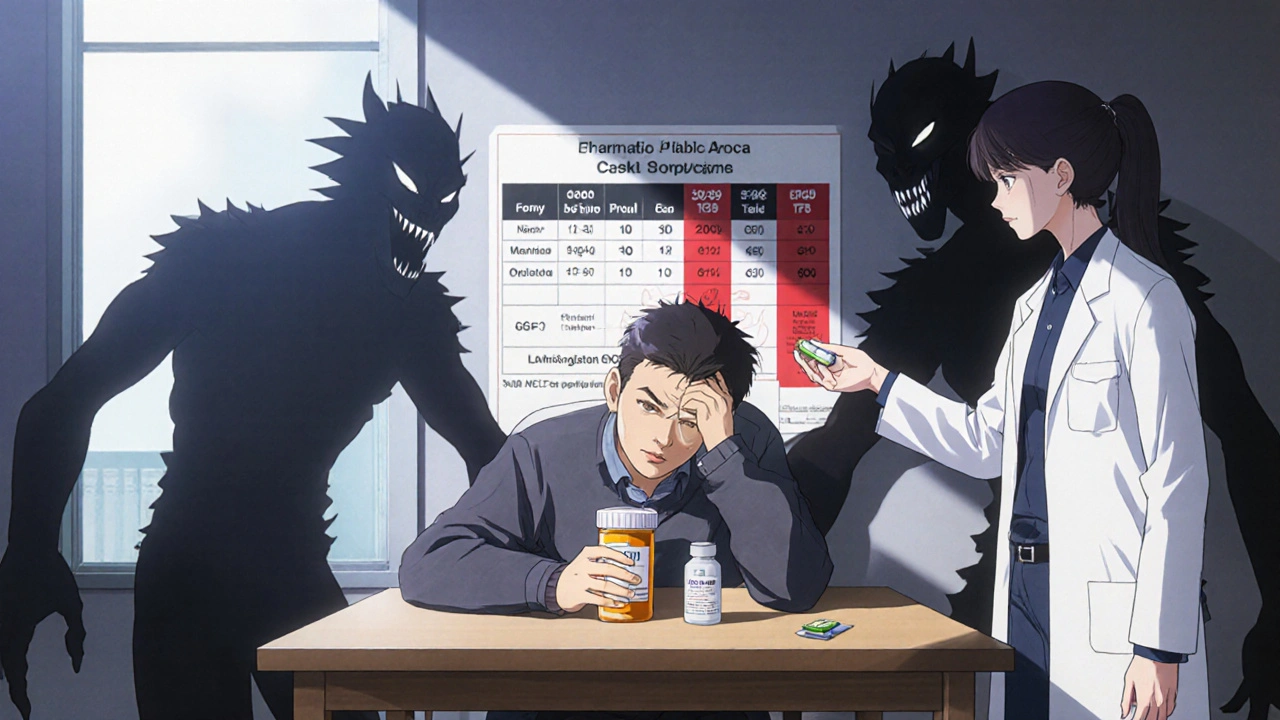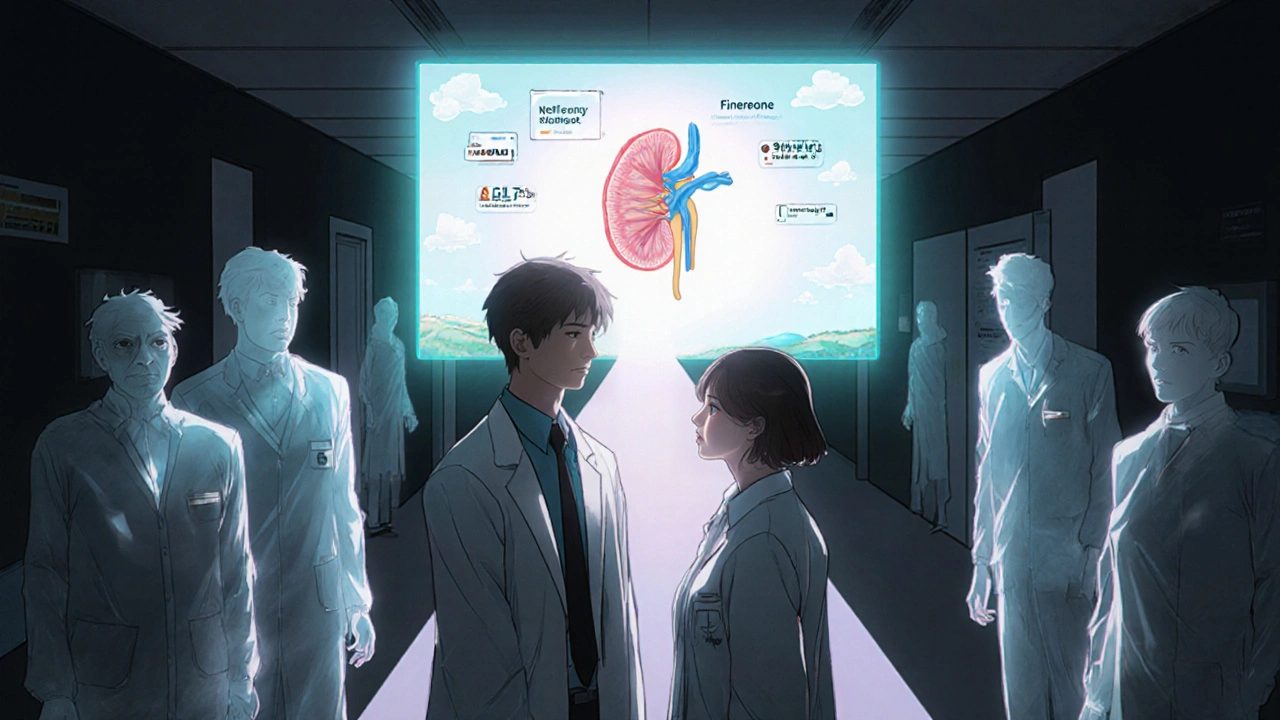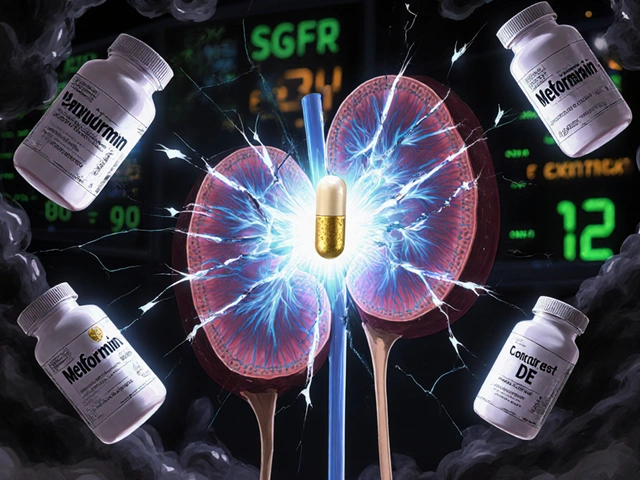Medication Safety in Kidney Disease: Dosing Adjustments and Nephrotoxin Avoidance

When your kidneys aren’t working right, even common medicines can turn dangerous. A simple ibuprofen for a headache might send your creatinine soaring. A diabetes pill you’ve taken for years could suddenly put you at risk of lactic acidosis. This isn’t scare tactics-it’s medicine. About 37 million Americans have chronic kidney disease (CKD), and nearly 28% of their hospitalizations are tied to medication errors. The truth? Most of these are preventable.
Why Kidneys Change How Drugs Work
Your kidneys don’t just make urine. They filter blood, remove waste, and clear out many drugs. When kidney function drops, those drugs stick around longer. That’s fine for some. For others, it’s a slow poisoning. The key number doctors use is eGFR-estimated glomerular filtration rate. It tells you how well your kidneys are filtering. Normal is 90 or higher. Once it drops below 60 mL/min/1.73 m², most medications need a rethink.Some drugs are cleared almost entirely by the kidneys. Aminoglycosides like gentamicin, vancomycin, and many antibiotics fall into this group. If you have CKD and get a standard dose, the drug builds up. You might end up with hearing loss, nerve damage, or worse. The fix? Longer gaps between doses. Instead of every 8 hours, it might be every 24 or 48 hours. That’s not guesswork-it’s based on pharmacokinetic studies and clinical guidelines.
But it’s not just antibiotics. Even your daily pills-like painkillers, blood pressure meds, or diabetes drugs-can become risky. The problem isn’t always the drug itself. It’s the dose. And that’s where most mistakes happen.
Top Nephrotoxins to Avoid
Not all drugs are created equal when it comes to kidney safety. Some are outright dangerous for people with CKD. These are called nephrotoxins. Here are the biggest culprits:- NSAIDs (ibuprofen, naproxen, celecoxib): These are the #1 cause of preventable acute kidney injury in CKD patients. They reduce blood flow to the kidneys. One study found that 68% of CKD patients didn’t realize OTC painkillers were risky. One Reddit user with stage 4 CKD took two Advil for a headache and ended up in the hospital with his creatinine jumping from 3.2 to 5.7 in 48 hours.
- Sodium phosphate bowel prep: Used before colonoscopies, this can cause severe kidney damage. New guidelines now recommend polyethylene glycol (PEG) instead-safe even for advanced CKD.
- Contrast dye: Used in CT scans, this can trigger contrast-induced nephropathy. If you have CKD, your doctor should check your eGFR first and may give you fluids or delay the scan.
- Metformin: A common diabetes drug. It’s safe until eGFR drops below 30. Between 30 and 45, use with caution. Below 30? Stop it. Lactic acidosis is rare but deadly.
Here’s the twist: Some drugs you think are safe aren’t. Antacids with magnesium or aluminum? Can build up and cause muscle weakness or confusion. Herbal supplements? Many are unregulated and loaded with kidney-toxic compounds. Always tell your pharmacist and nephrologist what you’re taking-even the “natural” stuff.
Dosing Rules Based on eGFR
There’s no one-size-fits-all dosing chart. But there are clear thresholds based on eGFR, backed by KDIGO 2024 guidelines:- eGFR ≥60: Most drugs can be given at standard doses. Still, monitor.
- eGFR 30-59 (Stage 3 CKD): This is where most adjustments begin. Antibiotics, diuretics, and some heart meds need lower doses or longer intervals.
- eGFR 15-29 (Stage 4): Significant reduction needed. Many drugs require therapeutic drug monitoring (TDM)-like checking vancomycin levels in your blood.
- eGFR <15 (Stage 5, not on dialysis): Almost all drugs need individualized dosing. This is where clinical judgment and pharmacist input are critical.
For example, insulin doesn’t need adjustment. But sulfonylureas like glipizide? High risk of low blood sugar. Switch to GLP-1 agonists or SGLT2 inhibitors instead. These are game-changers.

The SGLT2 Inhibitor Revolution
For years, doctors avoided diabetes drugs in CKD because they feared side effects. Then came SGLT2 inhibitors-like dapagliflozin and empagliflozin. These drugs don’t need any dose adjustment, no matter how low your eGFR is. Even at 10 mL/min/1.73 m², the standard dose still works.They’re not just safe-they’re protective. The CREDENCE trial showed they reduce the risk of kidney failure, dialysis, or death by 39%. That’s why KDIGO 2024 now recommends them for all CKD patients with albuminuria, even if they don’t have diabetes. They also help with heart failure and lower blood pressure. No other class of drug does all three.
And here’s the kicker: They’re not just for diabetics anymore. The guidelines now say if you have CKD and protein in your urine, you should be on one-regardless of blood sugar levels. That’s a major shift in thinking.
ACE Inhibitors and ARBs: Don’t Underdose
For decades, doctors held back on ACE inhibitors (like lisinopril) and ARBs (like losartan) in CKD because they worried about rising creatinine. They thought a higher creatinine meant kidney damage. It doesn’t. That small rise? It’s a sign the drug is working. It reduces pressure in the kidney’s filtering units.KDIGO 2024 calls underdosing these drugs “suboptimal care.” Clinical trials that proved their benefit used maximum tolerated doses. If your creatinine jumps by 30% or less in the first two months, don’t stop it. Adjust if it goes higher or if potassium rises above 5.5. The goal? Reduce albuminuria by at least 50%. That’s linked to slower kidney decline and lower heart risk.
And if you’re still on a low dose? Ask why. If your doctor says it’s “to protect your kidneys,” they’re using outdated logic.
What About Newer Drugs Like Finerenone?
Finerenone is a new type of mineralocorticoid receptor antagonist. It’s not a typical blood pressure pill. It’s specifically designed to protect kidneys in people with diabetes and albuminuria. KDIGO 2024 recommends it when you’re already on the highest tolerated ACE/ARB dose but still have high urine albumin (over 30 mg/g) and potassium under 4.8 mmol/L.It’s not for everyone. But for those who qualify, it cuts the risk of kidney failure by another 20-30%. It’s another tool in the toolbox-used after ACE/ARBs and SGLT2 inhibitors. It’s not a replacement. It’s an add-on.

Practical Steps for Safer Medication Use
Knowing the rules isn’t enough. You need a system. Here’s what works:- Get your eGFR checked every 3-6 months. Don’t wait for symptoms. If you have CKD, this is non-negotiable.
- Use one pharmacy. A 2023 NIDDK study found that patients using a single pharmacy had a 42% lower risk of medication-related kidney injury. Pharmacists can flag dangerous combinations.
- Review all meds quarterly. Even if you feel fine. Your kidneys change. Your meds should too. Ask your doctor: “Is this still safe for my current kidney function?”
- Ask about alternatives. If you’re on metformin and your eGFR is 38, ask: “Can I switch to a GLP-1 agonist or SGLT2 inhibitor?”
- Use a renal dosing app. Epocrates, Medscape, and others have built-in CKD calculators. They’re not perfect, but they’re better than guessing.
And if you’re in the hospital? Make sure someone checks your eGFR before giving any IV meds. A 2023 study found that 41% of hospitals don’t have protocols for adjusting doses during acute kidney injury. Don’t assume they know. Speak up.
What’s Next? Technology and Trends
The future of kidney-safe prescribing is digital. The Veterans Health Administration cut inappropriate dosing by 37% after adding eGFR alerts to their electronic health record system. But most clinics still don’t have this. A 2022 JAMA study found that 23.7% of CKD patients got at least one drug at a dangerous dose-because the system didn’t warn the doctor.By 2026, the FDA plans to use real-world data from EHRs to update renal dosing guidance. Pharmacogenomics is also entering the scene. Researchers are studying how genetic differences affect drug metabolism in CKD patients. That could one day mean your dose is tailored to your DNA, not just your eGFR.
For now, the best tool you have is knowledge. And a good relationship with your nephrologist and pharmacist. Medication safety in kidney disease isn’t about avoiding all drugs. It’s about using the right ones, at the right dose, at the right time.
Can I still take ibuprofen if I have kidney disease?
No, it’s not safe. NSAIDs like ibuprofen reduce blood flow to the kidneys and can cause sudden kidney injury, even in people with mild CKD. A single dose can spike creatinine and lead to hospitalization. Use acetaminophen (Tylenol) instead for pain, but never exceed 3,000 mg per day. Always check with your doctor before taking any OTC pain reliever.
Does metformin need to be stopped if my eGFR drops below 45?
Not necessarily. Between eGFR 30-45, metformin can still be used with caution-lower dose, no more than 1,000 mg daily, and close monitoring. Below 30, it should be stopped. But many doctors now switch patients to SGLT2 inhibitors or GLP-1 agonists at this stage because they’re safer and offer kidney protection. Ask your doctor if a switch makes sense for you.
Are SGLT2 inhibitors only for people with diabetes?
No. KDIGO 2024 guidelines now recommend SGLT2 inhibitors like dapagliflozin for all adults with CKD and albuminuria-even if they don’t have diabetes. They slow kidney decline, reduce heart failure risk, and lower blood pressure. The dose remains 10 mg daily regardless of eGFR. This is one of the biggest advances in kidney care in the last decade.
Why does my doctor want me to keep taking lisinopril even though my creatinine went up?
A small rise in creatinine (up to 30%) within the first 2 months of starting an ACE inhibitor like lisinopril is normal and expected. It means the drug is reducing pressure in your kidneys’ filtering units-which protects them long-term. Stopping it because of this rise is harmful. Only stop if creatinine rises more than 30% or if potassium goes above 5.5. Your doctor is likely following KDIGO 2024 guidelines, which say underdosing these drugs is suboptimal care.
What should I do before getting a CT scan with contrast dye?
Tell the radiology team you have kidney disease. Ask if the scan is absolutely necessary. If yes, request a low-dose or iso-osmolar contrast agent. Make sure you’re well-hydrated before and after. Some centers give IV fluids beforehand. Avoid NSAIDs for 48 hours before and after. If your eGFR is below 45, your doctor may delay the scan or choose an alternative imaging test like MRI or ultrasound.
How often should I have my medications reviewed if I have CKD?
At least every 3 months if you’re in stage 3 or worse. More often if your eGFR is changing quickly, you’re sick, or you’ve been hospitalized. Every time your meds are changed-even by a specialist-ask your primary doctor or pharmacist to do a full review. Many patients get conflicting advice from different providers. A single, coordinated review prevents dangerous overlaps or omissions.




Deepali Singh
Just saw a patient last week with eGFR 22 who was still on metformin because his PCP "didn't think it was a big deal." He ended up in ICU with lactic acidosis. This post is spot on. No one talks about how often doctors just copy-paste prescriptions without checking renal function. It's terrifying.
Sylvia Clarke
Let me just say - if your doctor doesn't know what eGFR stands for, you should probably find a new one. Or at least bring them this post. I once had a rheumatologist prescribe me naproxen for arthritis while I was stage 3 CKD. I had to educate him. He apologized. Then prescribed it again three months later. 🙃
Abdul Mubeen
Are we sure this isn't just Big Pharma pushing safer alternatives so they can sell more expensive drugs? I mean, why is PEG suddenly "safe" but sodium phosphate is "dangerous"? Who funded those guidelines? And why are we ignoring the fact that most CKD patients are on 12+ medications anyway? This feels like a distraction.
mike tallent
Biggest tip I give my patients: Make a med list. On paper. In big letters. Bring it to every appointment. Even if it's just ibuprofen or turmeric pills. I had a guy take "kidney cleanse" tea for 6 months - turned out it had aristolochic acid. Nephrotoxic as hell. 🚨 No judgment, just awareness. Your kidneys don't care if it's "natural."
Joyce Genon
Look, I get that people want to feel empowered, but let’s not pretend this is some groundbreaking revelation. Every nephrologist knows this. The problem isn’t lack of knowledge - it’s the fact that primary care docs are overworked, underpaid, and pressured to prescribe quickly. Also, most patients don’t even know their own eGFR. So who’s really at fault here? The system? The patients? Or the fact that we’ve turned medicine into a checklist culture?
John Wayne
It's amusing how people treat eGFR like a sacred number. The truth is, it's an estimate. Sometimes wildly inaccurate. And the guidelines? Written by committees who’ve never seen a real patient in a clinic. I've seen people with eGFR 40 function better than those with 70. Medicine isn't algorithms. It's people.
Julie Roe
I’ve been managing CKD for 12 years, and the single most helpful thing was learning how to ask my doctors: "Is this cleared by the kidneys? What’s the adjusted dose?" It sounds simple, but most people don’t even know to ask. And honestly? Pharmacists are your secret weapon. They know this stuff better than most doctors. Don’t be shy - ask them. I’ve saved myself from two potential disasters just by walking into the pharmacy and saying "I have stage 3 CKD, can you check this?"
jalyssa chea
why do we even have guidelines if no one follows them my dr just gave me celecoxib last month and said its fine i have eGFR 28 and now im scared to even take tylenol
Gary Lam
As someone who grew up in India where everyone swears by "herbal kidney detox" - let me tell you, this post is life-saving. My uncle took some "ayurvedic kidney tonic" and ended up with acute tubular necrosis. Turns out it had heavy metals. No regulation. No labels. Just magic potions. Please, if you're taking anything labeled "natural" or "ancient remedy," talk to a nephrologist first. Not your cousin who read a blog.
Peter Stephen .O
Y’all need to stop treating meds like candy. I had a friend take 8 Advil a day for back pain - he thought it was "just inflammation." His creatinine went from 1.1 to 7.4 in 3 weeks. He didn’t even know he had CKD. Now he’s on dialysis. This isn’t hypothetical. This is your neighbor. Your uncle. Your future self. Don’t wait for a crisis to learn this stuff.
Andrew Cairney
Did you know the FDA doesn't require drug manufacturers to test kidney safety in CKD populations? That's right. Most dosing guidelines are based on tiny studies from the 90s. The whole system is a house of cards. And now they want us to trust eGFR? I’ve seen it fluctuate 30 points in a day from dehydration. This isn't medicine - it's guesswork with a fancy acronym.
Rob Goldstein
For those managing CKD: Always ask for therapeutic drug monitoring (TDM) when on vancomycin, aminoglycosides, or lithium. It’s not optional - it’s standard of care. Also, if you’re on a beta-blocker like atenolol or a diuretic like furosemide, dose reductions are often needed at eGFR <50. Many providers miss this. Bring a printed KDIGO guideline to your appointment. Most will appreciate the initiative.
vinod mali
in india we dont even have access to eGFR tests in small towns. people just take whatever the doctor gives. i saw a man with creatinine 6.5 on ibuprofen. no one knew. no one cared. this post is for rich countries. we need basics first.
Jennie Zhu
While the clinical implications outlined in this communication are both clinically salient and statistically significant, it is imperative to acknowledge the heterogeneity of renal clearance mechanisms across pharmacokinetic classes. The KDIGO 2024 recommendations, while evidence-based, require individualized application contingent upon comorbidities, polypharmacy burden, and tubular secretion dynamics - factors frequently underrepresented in population-level guidelines.
Kathy Grant
I used to think my kidney disease was just bad luck. Then I realized how many of my meds were quietly killing me. I stopped everything - even my vitamins - and started asking questions. It took me months to find a doctor who listened. But now? I have a binder. Color-coded. With pictures. And I bring it to every appointment. I’m not just surviving anymore. I’m advocating. And if you’re reading this and you have CKD? You can too. You’re not alone. Your voice matters. Even if you’re scared. Even if you’re tired. Speak up. Write it down. Bring it. They need to hear you.